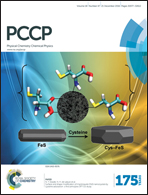First-principles calculations of the electronic structure and bonding in metal cluster–fullerene materials considered within the superatomic framework†
Abstract
Inspired by recent success of synthesizing cluster assembled compounds we address the question to what extent the three new materials [Co6Se8(PEt3)6][C60]2, [Cr6Te8(PEt3)6][C60]2, and [Ni9Te6(PEt3)8]C60, upon forming bulk compounds, imitate atomic analogues. Although experimental results suggest the latter, a theoretical approach is the method of choice for offering a conclusive answer and for studying the actual superatomic character. The concept of superatoms for describing atom-imitating clusters is very intriguing since it allows chemists to apply their chemical intuition – a useful tool for predicting new materials – when it comes to inter-cluster reactions. Thus, we systematically study the lattice structure, the intercluster binding, and the electronic structure by density functional theory and assess them in terms of their superatomic features. We show that collective properties arise upon bulk formation, which promotes arguments for the formation of solids in which the constituent clusters have a superatomic character that determines some form of chemical bonding. Additionally, we find evidence for the formation of superatomic states. Unfortunately, however, due to the mixing of electronic states of transition metals and chalcogen atoms, no typical electronic shell closing in the cluster cores can be identified.


 Please wait while we load your content...
Please wait while we load your content...